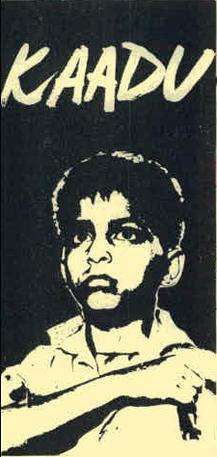Kaadu (1973 Kannada film)
Kaadu (Forest) is a 1973 Indian Kannada film written and directed by Girish Karnad. The screenplay was based on a novel of the same name by Srikrishna Alanahalli. It stars Master G. S. Nataraj, Amrish Puri and Nandini Bhaktavatsala in the lead roles. The film won awards at the 21st National Film Awards and the 21st Filmfare Awards South.
| Kaadu | |
|---|---|
 | |
| Directed by | Girish Karnad |
| Produced by |
|
| Written by | Srikrishna Alanahalli |
| Screenplay by | Girish Karnad |
| Based on | Kaadu (1972) by Srikrishna Alanahalli |
| Starring | Master G. S. Nataraj Amrish Puri Nandini Bhaktavatsala |
| Music by | B. V. Karanth |
| Cinematography | Govind Nihalani |
| Edited by | P. Bhaktavalsalam |
Production company | L. N. Combines[1] |
Release date |
|
Running time | 141 minutes[1] |
| Country | India |
| Language | Kannada |
Kamal Haasan called it one of his favourite films and said this film served as inspiration for his film Thevar Magan (1992).[2]
Plot
Kitti, an eight-year-old boy, is brought from a city to a village called Koppal by his uncle, Chandre Gowda. Gowda is married to Kamali and the couple are childless. Kitti develops a deep attachment to Kamali and the thick forests in Koppal. Gowda is a frequent visitor to a nearby village called Hosur, where he has a mistress, Basakka. Kamali is aware of her husband's extra marital relationship, but remains helpless. On one evening, Kamali takes Kitti and a servant along with her to the forest. They meet a witch who performs a sacrifice which is meant to keep Gowda away from Basakka. He assures Kamali that he will get back her husband from the fold of Basakka. Kitti gets to know about his uncle's extramarital affair. The fight between two individuals turns into a feud between the two villages. Kamali is convinced that the effect of the witchcraft is beginning to take place. Meanwhile, Gowda gets a message from Basakka, asking him not to come to Hosur as his life might be under danger. Gowda thinks that his pride is hurt, and to prove his courage he sends her a message that he will come the following night. A distressed Kamali makes a second attempt to keep her husband at home. She decides to go to the witch but is fatally attacked by Shivaganga's men on the way. This leads to the villagers of Koppal launch a massive attack on their Hosur counterparts. In the fight that ensues, Shivaganga gets killed by Gowda's servants. The police come to the village and arrest the criminals and set up an outpost near the villages, and ask the villagers to pay fine for its maintenance. This also ensures that the villagers are refrained from conducting the Nyaya.
Cast
- Master G. S. Nataraj as Kitti, Gowda's nephew
- Amrish Puri as Chandre Gowda
- Nandini Bhaktavatsala as Kamali, Gowda's wife
- Lokesh as Shivaganga
- Uma Shivakumar as the Basakka, Gowda's mistress
- Kalpana Sirur
- T. S. Nagabharana
Production and theme
The film is based on a novel of the same name by Kannada writer Srikrishna Alanahalli.[3] The story combines three interdependent themes – the tragedy that shocks the village, the tragic story of Kamali, and the story of the eight-year-old boy who visualises all these events. The story is seen through the eyes of Kitti.[4] Ashish Rajadhyaksha and Paul Willemen in their book, Encyclopedia of Indian Cinema, noted that the boy cannot distinguish between the "man-made violence" and the "primeval threats" presented by the dense forest; according to a legend, the forest has a killer bird that calls out its victims by name.[1]
The film was Karnad's first venture as an independent director.[lower-alpha 1] Amrish Puri, a regular face in Shyam Benegal's films was chosen to play the main lead. The cinematography was handled by Govind Nihalani,[6] who was also associated with Benegal.[1] B. V. Karanth composed the film score and was in charge of art direction.[4] T. S. Nagabharana, who would later go on to become an independent filmmaker, worked as a costume designer and assisted Karnad in the film.[1]
Legacy
Kaadu is regarded as one of the earliest Parallel Cinema in the Kannada film industry. Ashish Rajadhyaksha and Paul Willemen in their book, Encyclopedia of Indian Cinema, noted that Karnad's Kaadu and Benegal's Ankur placed both filmmakers "squarely within New Indian Cinema's ruralism".[7]
Kamal Haasan called it one of his favourite films and said this film served as inspiration for his film Thevar Magan (1992).[2]
Awards
21st National Film Awards
- Second Best Feature Film – K. N. Narayan, G. N. Lakshmipathy (producers) and Girish Karnad (director)[4]
- Best Actress – Nandini Bhaktavatsala[4]
- Best Child Artist – Master G. S. Nataraj[4]
21st Filmfare Awards South
4th International Film Festival of India
- Special Mention Award[9]
Footnotes
- He co-directed his debut film Vamsha Vriksha alongside B. V. Karanth.[5]
Citations
- Rajadhyaksha & Willemen 2014, p. 418.
- https://www.hindustantimes.com/interactives/kamal-hassan-70-movies/
- Lal, Mohan (1992). Encyclopaedia of Indian Literature: Sasay to Zorgot. Sahitya Akademi. p. 480. ISBN 978-81-260-1221-3.
- "21st National Award for Films". Directorate of Film Festivals. Archived from the original on 1 November 2013. Retrieved 4 October 2016.
- Rajadhyaksha & Willemen 2014, p. 411.
- Moudgi, Reema (10 November 2014). "Nihalani Returns to Bengaluru With a Rich Cache of Memories". The New Indian Express. Retrieved 4 October 2016.
- Rajadhyaksha & Willemen 2014, p. 122.
- Reed, Sir Stanley (1984). The Times of India Directory and Year Book Including Who's who. Bennett, Coleman. p. 235.
- Das, Nandini (1985). Indian films today: an anthology of articles on Indian cinema. Directorate of Film Festivals, National Film Development Corp. ISBN 978-81-201-0000-8.
References
- Rajadhyaksha, Ashish; Willemen, Paul (2014). Encyclopedia of Indian Cinema. Routledge. ISBN 978-1-135-94318-9.